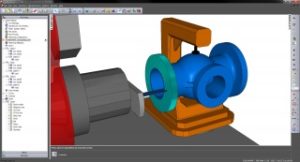Delcam launches FeatureCAM for feature-based programming
In the picture: Turning-head holders have been added to the range of machining accessories supported by FeatureCAM.
 Delcam has launched the 2015 R3 release of its FeatureCAM feature-based CAM software. This includes a range of enhancements to give high-quality results on all types of machine tool, including complex mill-turn equipment and five-axis machining centres, while retaining the rapid programming times for which FeatureCAM is renowned.
Delcam has launched the 2015 R3 release of its FeatureCAM feature-based CAM software. This includes a range of enhancements to give high-quality results on all types of machine tool, including complex mill-turn equipment and five-axis machining centres, while retaining the rapid programming times for which FeatureCAM is renowned.
FeatureCAM was the world’s first feature-based programming software when it was launched in 1995. Constant development since then has ensured that the system has retained its leadership in programming speed and ease of use, while an increased range of strategies has been added to provide more efficient toolpaths that give greater productivity on a wider range of machinery, including mill-turn machines, five-axis mills and wire EDM equipment.
The most significant new option is the ability to duplicate the physical constraints of the machine tool in simulations in FeatureCAM. Machine-tool limits can be added to the models to be used in the simulation for three-, four- and five-axis milling machines, for turning equipment, and for mill-turn machines, including those with multiple turrets and/or multiple spindles.
It is then possible to check that the chosen machine tool is capable of completing the proposed program for all types of equipment, from the simplest lathe to the most complex multi-tasking machine.
The simulation will pause whenever the program attempts to move the machine beyond the specified limits. In many cases, simply changing the position of the part on the machine bed will allow the whole operation to be completed.
Alternatively, modifications to the fixturing or to the length of the cutting tools may be required. Whatever changes are made, the computer simulation can then be repeated to check that the modified program will run successfully.
Proving out the program on the computer will save time and money on the machine tool, as well as checking that the part can be cut safely.
In another improvement to FeatureCAM simulations, more accurate representations can be created of shanks and holders. These allow three-axis and five-axis collision checking to be undertaken more reliably.
Two enhancements have been made to five-axis machining with FeatureCAM. Firstly, more control is available with the ability to set the C-axis orientation about the Z axis so helping to avoid machine collisions and to make the program more efficient by avoiding over-travel. Secondly, support for five-axis operation is possible in 2D spiral operations, giving better control of the tool axis. This can ensure uniform depth of cut and cross-section when engraving onto complex surfaces, including parts with undercuts.
Additional accessories that are supported in the new release include turning-head holders and mini turrets. Turning-head holders allow turning to be undertaken on a milling machine, while mini turrets allow more flexible positioning of the tooling and faster tool changes. In both cases, the new options can be simulated on the computer before being sent to the machine.



